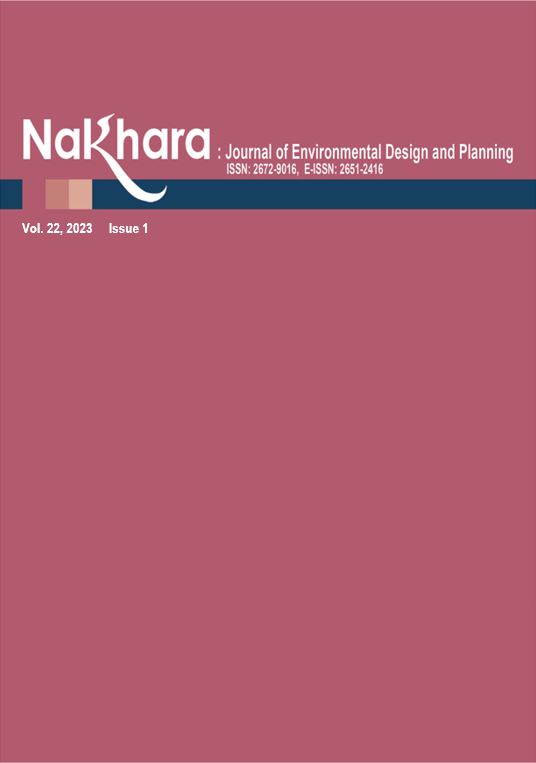A Study of Shading Devices in Modern Architecture for the Hot Humid Climate of Phnom Penh, Cambodia
Main Article Content
Abstract
Due to global warming caused by carbon dioxide emissions, for the last decade or longer, there has been a strong focus on reducing energy consumption. Among the many technologies, old and new, available for this purpose, one is a shading device, which is required in a hot and humid climates to protect building interiors from solar radiation that can penetrate the building, increasing the energy demand for the cooling load. Such shades are well-known and have been used widely since the dawn of the modern architectural era. In Phnom Penh, there are different kinds of shading devices in modernist architecture that demonstrate creativity in the shading of façades. To maximize their effectiveness in contributing to the fight against global warming, it is necessary to study their fundamental shadowing behaviors so that new technology can be developed and applied to today’s buildings.
This study aims to explore the shading types in modern architecture in Phnom Penh, and evaluate different aspects of these shading devices in terms of shadow performance by using an extension tool in Sketch-UP, Shadow Projector V.7 by TIG.
The results show that shading devices on modern buildings in Phnom Penh are defined by a deep overhang, and horizontal louvers hung from the overhang. Vertical fins, slanted fins, and egg-crate patterns are also used on the façades. According to the evaluation results, egg-crate provided the best shading performance among all shading cases and orientations studied. It was also found that a horizontal louver hung from the overhang can increase shading performance by 20% in all directions, and that it is more efficient than vertical fins for East, West, SE, and SW orientations. Moreover, the overhang is the most efficient in north-facing façades. Vertical fin types, on the other hand, are unreliable for East, West, SE, and SW orientations. The vertical slanted fin type is also unreliable in any orientation or season due to the slanted position and the sun's travel path.
The results of this study will help designers optimize the shadowing behavior of shading devices, particularly with respect to building orientation. The research findings highlight the fundamentals, which can be enhanced future studies that focus on compatibility assessment of shading devices used in new-era buildings.
Article Details

This work is licensed under a Creative Commons Attribution-NonCommercial-NoDerivatives 4.0 International License.
References
Asimakkopoulos, D., & Santamouris, M. (1996). Passive cooling of building. James & James.
Chaiyakul, Y. (2008). Google sketchup for shading and daylighting analysis. Faculty of Architecture, Khon Kaen University. https://arch.kku.ac.th/pr/wp-content/uploads/2011/08/Abstract36.pdf
Guedes, P. (2021). Behind the veils of modern tropical architecture. Docomomo Journal, 63, 6–17. https://doi.org/10.52200/63.A.7LQWCQXU
Lechner, N. (2015). Heating, cooling, lighting: Sustainable design methods for architects (4th ed.) Jonh Wiley & Sons.
Ross, H. G., & Collins, D. L. (2006). Building cambodia: New Khmer architecture 1953-1970. Bangkok, Thailand. The Key Publisher.
Sereypagna, P. (2017). New Khmer architecture: Modern architecture movement in Cambodia between 1953 and 1970. Docomomo Journal, (57), 12–19. https://doi.org/10.52200/57.A.UHKJCPEU
Szokolay, S. V. (2007). Solar geometry. PLEA: Passive and Low Energy Architecture International.
The World Bank Group. (2021). Cambodia - country specific information. Climate Change Knowledge Portal.
Ty, P. (2017). Tropical strategy of modern architecture in Cambodia for the design of a contemporary art space in Phnom Penh [Master’s thesis, Chulalongkorn University, Bangkok, Thailand].
TIG. (2019) Shadow projector (Version 7). [Computer software]. Sketchucation. https://sketchucation.com/plugin/1292-tig_shadowprojector
United Nations. (2015). UN projects world population. https://news.un.org/en/story/2015/07/505352-un-projects-world-population-reach-85-billion-2030-driven-growth-developing
Wong, L. C. (2011). The changing role of water in the spatial construction and design of Southeast Asian polities. Nakhara: Journal of Environmental Design and Planning, 7, 11–24. https://ph01.tci-thaijo.org/index.php/nakhara/article/view/104969

